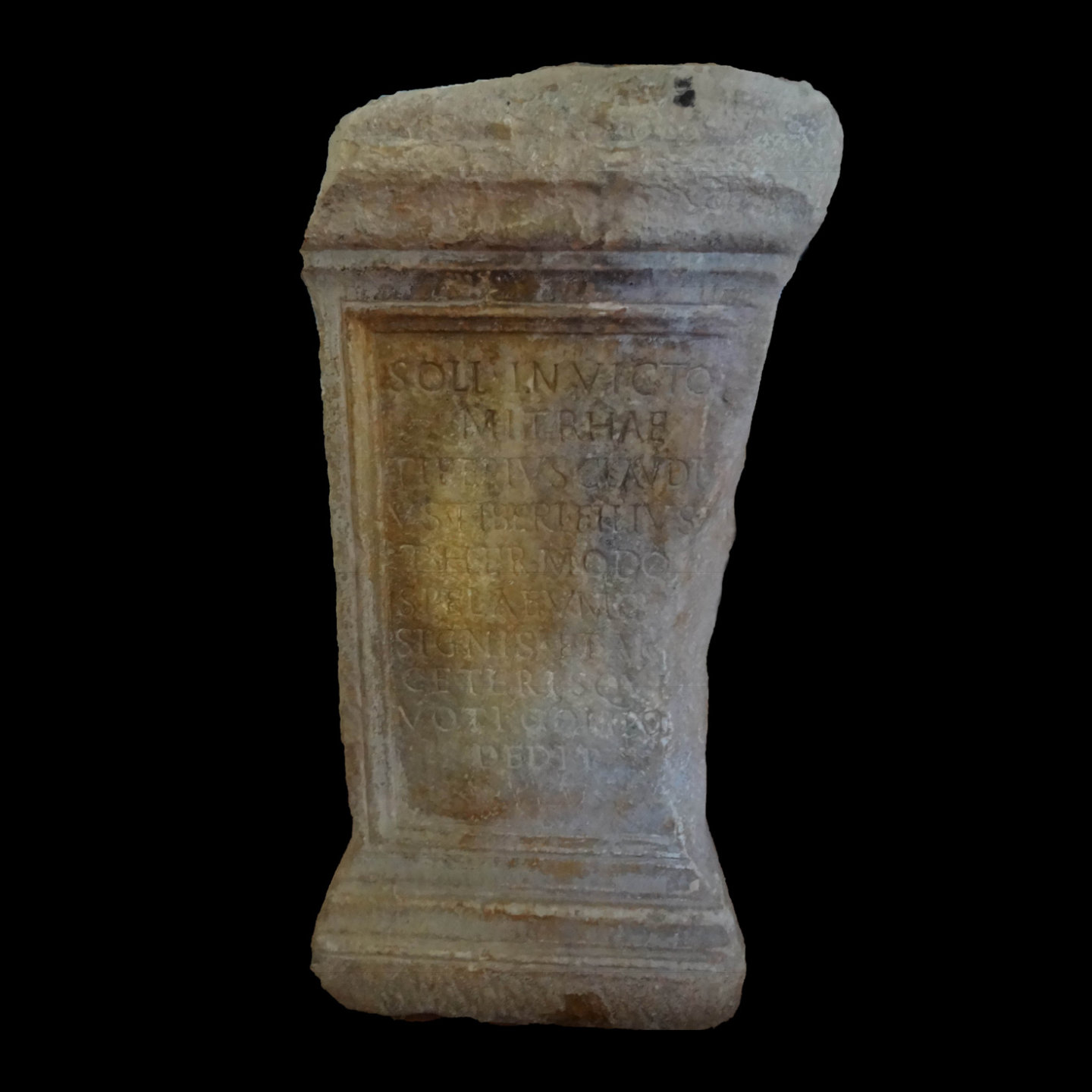Biography
of Tiberius Claudius Thermodon
TNMP 224
The dedicator, Tiberius Claudius Thermodon, was also the author of a dedication to Diana at Ficulle (Ficulea), in the territory of Volsinii (CIL XI 2683), and a third to Fortuna Primigenia, deposited at Praeneste (CIL XIV 2853). His cognomen, derived from the name of an Anatolian river, suggests a Micrasian origin for this man, who may have been a local merchant.
As mentioned, within the borders of the region various factors seem to hint at the ways the local Etrurian elites responded to these indirect 'religious directions' from above: among these factors, one of the most emblematic is the marble altar from the territory of Volsinii, which, in the late 2nd century, was dedicated by the distinguished citizen Thermodon, commissioner of a Mithraic antrum in the territory of his city, as testified by the surviving inscription.
To understand the deep meaning of Thermodon's Mithraic devotion, it is necessary to spend some words on his social background and on the class to which he belonged to. Tiberius Claudius Thermodon, indeed, belonged to the ranks of Imperial freedmen, as evidenced by his praenomen which identifies him as a descendant of slaves freed under the reign of Claudius. The freedmen, in fact, found their more profitable occupations in the public administration, where they held key positions. Thus, the State boasted a very large number of them, an entire caste, directly subordinate to the central government. Consequently, due to the indissoluble forge of their relationship with the Emperor, they played a crucial role in creating consensus among the population, and prime importance was given to crucial responsibilities such as spreading government-promoted iconographies or managing the state marble industry.
The clearest indicator, however, of the privileged bond between the freedmen and the government is the monopoly of the Imperial cult, reserved from Augustus onward, to the Caesari servi; having in the Prince their direct patron, the Imperial freedmen were indeed the most suitable candidates to perform the sacred rites for the Domus Divina. The pervasive diffusion of this State-cult in Etruria has been well described by the abundance of contexts where evidence of its priesthood have come to light, as in Veii (CIL XI 3781), Falerii (CIL XI 3083), Lucus Feroniae (CIL XI 3938), Nepet (CIL XI 1801), and Luna (CIL XI 1344b).
These priests, the sevires Augustales, could only slavishly accommodate the choices of the government they served, and one of the most logical and common ways of doing so was by mimicking its religious inclinations. Hence, for example, when in 2nd century Falerii, the sevir Caius Metilius Saturninus accomplished his vow to the goddesses Isis and Cybele, he was certainly responding to the implicit directive coming from a higher office indicating that these deities were worthy of honour.
Thermodon, though not being a sevir himself, was an illustrious personage within his community, and likely a preeminent public figure. His religious actions, carried out for the benefit of all his citizens, followed the instructions of the ruling power, whose approval from above had to have been a prerequisite in selecting the deities to honour. Therefore, his ostentatious Mithraic devotion could only be explained in light of the government's growing involvement with solar cults: the freedman thus appeals to the dome of power from which he draws his own freedom, and his act of dedication is nothing more than an implicit self-legitimation of his own authority and a search for consensus.
Furthermore, perhaps an even more striking proof of the affiliation of local administrative classes to the mysteries comes from Cosa, where the mithraeum is lodged within the local curia. Worship here is in fact officiated inside the most important public building, the devotional core for the body of magistrates of the colony and the entire community. It is impossible not to draw a parallel with the contemporary presence of a spelaeum in Rome's Capitoline Hill, a source of inspiration for civic religious spaces across the entire Res Publica; spaces where the main buildings, in Rome as in Etruria, served as favoured theatres for the decuriones to perform the ceremonies of the Imperial cult.
Hence, while the curiae of Caere, Saturnia, Pisa, and many other cities of the Regio witnessed the veneration of the Emperor's genius, the equivalent building in Cosa housed a mithraeum, probably entrusted with a similar social role. In this regard, it is also worth mentioning the temple of Liber Pater in Cosa which, like the curia, overlooked the city forum. The well-established association of Liber with the Princeps and the Imperial cult is, in fact, another crucial signal hinting at how the religious landscape of the area was a cleverly designed stage for loyalty to the Empire.
It is not so arduous at this point to imagine members of the class of freedmen in Cosa wearing magistrate vestments while taking part in initiations in the curia's mithraeum. Furthermore, based on this comparison, a strategic location could also be assumed, with the due caution, for Thermodon's sanctuary. Both choices made in Cosa and Volsinii, in fact, coherently echoed the officials, common practice of promoting, as a demonstration of allegiance, the government-endorsed worships, including the cult of Mithras, which developed within the Roman administrative milieu.
These Etrurian settings, thus, are not isolated cases, but instead they mirror a large number of analogous situations, starting from the intent of eminent Imperial freedmen to encourage the Mithraic mysteries in Rome ever since the reign of Trajan. Ultimately, the mysteries of Mithras, which shared with the piety for the Prince the same function of crystallising social order, embodied one of the many facades the Imperial cult manifested to his subjects, in Etruria as well as in the rest of the Empire.
Mentions
Inscription by Claudius Thermodon of Bolsena
The donor of this Mithraic inscription from Bolsena, a certain Tiberius Claudius Thermoron, is known from two other monuments.
TNMM 652
References
- Bricault; Roy (2021) Les cultes de Mithra dans l'Empire Romain
- Nicola Luciani (2018) Mithras in Etruria. Characteristics of a mystery cult in the Roman Regio VII

